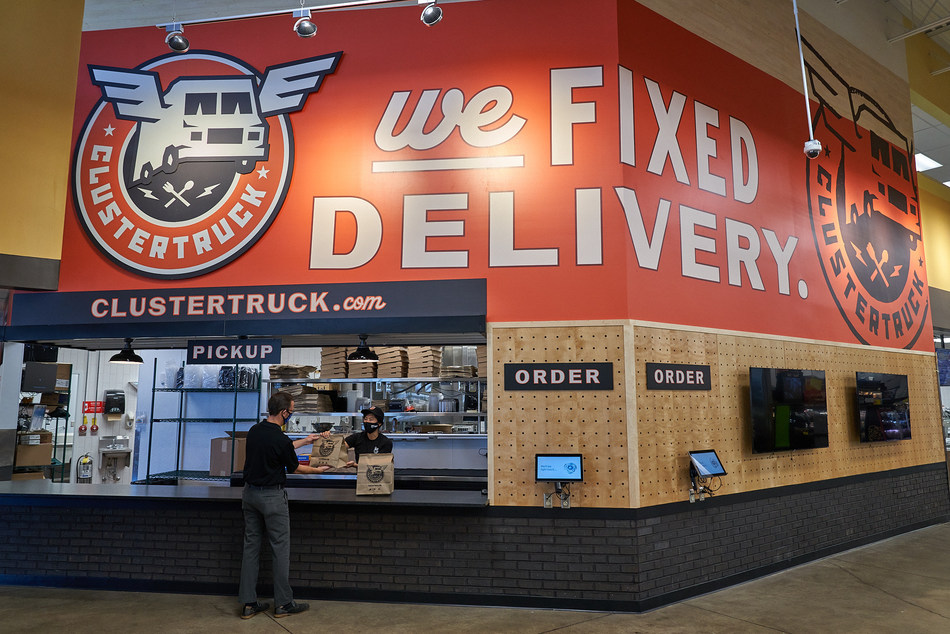Ghost-kitchen operator ClusterTruck and grocery juggernaut Kroger have been expanding on a partnership that they first inked last year.
Read our previous coverage on the partnership in which Kroger lent its branding to the Indianapolis-area ghost kitchen operator under the flag Kroger Delivery Kitchen, Powered by Kroger.
The pair recently announced more new locations, including two locations in the middle of Kroger grocery stores. The first has already opened, and at 1,000 square feet of space, it’s the product of millions of orders worth of learning.
“With our new footprint, we’re still making 80 to 90 items, but we’ve gone from 2,500 to about 1,300 square feet; our Kroger location is about 1,000 square feet,” said ClusterTruck Founder Chris Baggott. “There were no cuts to menu or capacity. Everything is still fresh and scratch-made, but we’ve fundamentally changed how food is cooked. We’ve had to reinvent processes.”
Baggott didn’t elaborate on those proprietary cooking tricks, but he said the same lessons were going to shrink the size of future ClusterTruck locations. A new location is set for the midtown area of Indianapolis, utilizing a restaurant building that closed during COVID. All the lessons learned in the four current locations, he said, will mean more efficient operations and less costly investment.
“It’s all very modular, our equipment package is a lot smaller than before. We’ve added a lot of tech and a lot of technology. ¬So, our break-even point has lowered significantly,” said Baggott. “We are cooking very differently. It’s not a Flippy robot or anything—we’re doing it and we’re doing it profitably.”
He said that new package is also in the Kroger kitchen, and allowed the partners to get the ghost facility going in just 30 days in the grocery store’s deli area, which already had the key infrastructure like a hood, plumbing and power.
There are more learnings to come, both for the companies and customers. The delivery model and the traditional pick-up mindset don’t exactly mesh yet.
“Kroger, as part of the test, wanted to study customer behavior on pickup. The problem with pickup for us is our entire model is designed to have the food in the hands of the customer in no more than seven minutes since it’s been cooked. If I’m delivering to you, I can control that,” said Baggott. In the Kroger model, he said, customers place an order and go shopping, and even if they’re standing at the counter, they have groceries and will still need to go to the car and unload their groceries, drive home, etc. “By the time you sit down to eat it’s been 30 minutes,” he added.
For the exacting model of ClusterTruck and all the technology behind the counter, that’s probably more of an annoyance for Baggott and his team than the consumer. He really doesn’t want your fries getting cold. The AI sending orders to cooking stations, scheduling drivers and routing them is also not set up for pickup. For instance, if the location has a 26-minute delivery time, it’s going to send the order at the 12-minute mark, accounting for eight minutes of cooking and a six-minute delivery. That could mean the pick-up customer waits more than 20 minutes for a burrito—not ideal.
“We’re telling people to place your order, schedule it and we’ll bring it to you. Why worry about taking it home and getting cold?” said Baggott.
Of course, the machine learning behind the system and the team will probably figure it out. He added that’s one of the things they’re figuring out since launching two weeks ago.
Above all, the expanded test serves as the next step for ClusterTruck and Kroger, the latter acting as a bit of a patron to the startup. Those first tests were as much about alignment as testing out the model.
“I think a big part of it was just the culture fit, we’re a small scrappy startup and they’re one of the oldest and smartest companies in the U.S. The good news is it was compatible,” said Baggott. “Think of Chipotle. If it wasn’t for McDonald’s would Chipotle be Chipotle? They came in and invested and helped them grow over seven years until they went public. We see that as a model—we’re inventing a category just like Chipotle and having a well-heeled big brother is helpful.”


